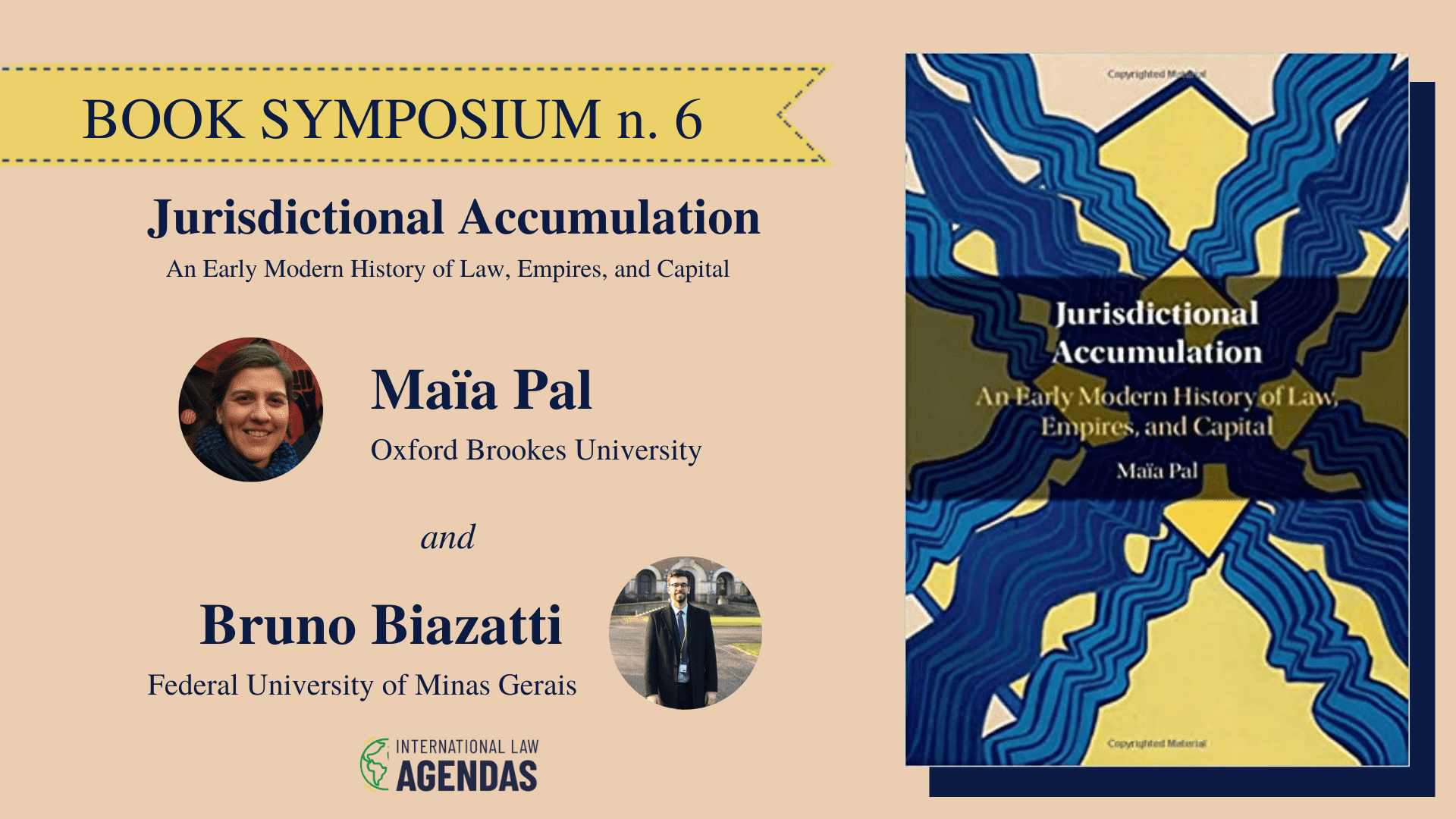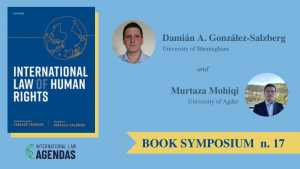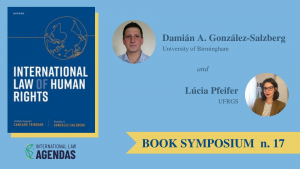If I had to describe Maïa Pal’s new book Jurisdictional Accumulation: An Early Modern History of Law, Empires, and Capital in one word, I would choose ‘shift’. The book should not be simply read as another academic production of the ‘historiographical turn in International Law’ (IL). By providing a new vocabulary and new categories to change the way we perceive and study extraterritoriality and jurisdiction in early modernity, Pal delivers a relevant contribution for freeing critical international legal historiography from its entrenched conceptual shackles. The intellectual potential of this approach is, to say the least, immense.
In my view, Pal proposes two main methodological shifts in the historiography of IL. First, her work invites us to look at private and less formal spaces and relations in the history of IL, elements which have been neglected by both mainstream and critical histories. In this sense, she revisits the long-lasting conception of empire-building in early modernity: instead of traditional state-driven colonial and imperialistic practices, based on the distinctive European concept of territorial sovereignty, she rather focuses on commercial, informal and private manifestations of jurisdiction (67-68). This approach separates her from sovereignty-focused critical histories. One may even wonder how Martti Koskenniemi’s upcoming book To the Uttermost Parts of the Earth: Legal Imagination and International Power 1300–1870 (in which he discusses state- and empire-formation in early modern Europe through the combination of sovereign power and property rights) relates to Pal’s work.
On a ratione personae perspective (and borrowing David Kennedy’s terminology), Pal is not interested in the foreground of empires, that is, the role of kings, state ministries and the traditional activities or immunities of ambassadors. She instead investigates empires’ background (the ‘shadows of empire’ (274)), focusing on actors that did not have sovereign powers in a strictly formal and legal sense, but had an undeniable role in creating and exercising jurisdictional (not necessarily territorial) arrangements that were essential in the preservation and expansion of empires. Those actors included consuls, magistrates, clergymen, and merchants. As such, the book challenges the internal-external and public-private binaries behind intellectual narratives of state-formation and extraterritoriality in early modernity. Pal correctly points out that these binary narratives turn a blind eye to certain forms of jurisdictional agencies that were key for empire-building, especially those encompassing commercial or outsourced practices (250, 252, 273). She named them ‘hidden practices of jurisdictional accumulation’ (124) and her ultimate goal is to include them in the historiography of IL.
As for the second methodological shift, her book proposes re-focusing the historiography of IL from doctrinal and intellectual materials to practice. She dives into early modernity though the lenses of social property relations, and not of scholarly materials of that time (9). This approach separates her historical narrative from critical histories focused, for instance, on the doctrinal origins of IL.
Naturally, due to the depth and novelty of her intellectual endeavor, Pal had the challenging task of laying strong and comprehensive analytical and conceptual grounds for her own work and for future studies. In fact, approximately half of her book is dedicated to these methodological aspects. In essence, she approaches historical sociology through a Political Marxist methodology, in order to provide a new narrative of social property relations in early modernity. The main concept introduced in the volume is ‘jurisdictional accumulation’, which refers to the accumulation of claims, rights, titles and functions by various sub-sovereign diplomatic and imperial actors, and the associated accumulation of revenue from those legal requests and privileges (3). As a corollary of this concept, Pal presented a new social property-based typology to explain imperial expansion in early modernity, differentiating extensions, transplants and transports of authority (7-8). In this approach, jurisdiction operates in a sui generis manner, in the sense that a universalistic concept of jurisdiction, common to and encompassing all empires, is not only methodologically flawed, but also fails to capture the totality of practices towards empire-building in early modernity. Consequently, jurisdictional accumulation breaks up the historical link between jurisdiction and sovereignty, resulting in the disruption of the linear and Eurocentric histories of territorial sovereignty that continue to dominate the theory and historiography of IL (7).
By tearing down walls analytically restraining the concept of jurisdiction, Pal’s novel concept of jurisdictional accumulation leads to the question of overreach. Although the book clearly demonstrates how traditional (sovereignty-based) notions of jurisdiction are under-inclusive, it remains unclear which methodological tools could be employed to avoid over-inclusiveness. In other words: Which practices and actors should not be considered as covered by the concept of jurisdictional accumulation? Which elements or indicators should a researcher look to answer the previous question while assessing certain empire? Pal’s call for more ‘specificity and complexity’ (9) as well as nuance taking into account the specific context of each empire under evaluation (17, 19) constitutes relevant guidance, since it points to the need for case-by-case appraisals. Yet, additional comment on this point could be welcoming as a means to further consolidate the strength of her conceptual framework.
One also wonders what other histories of IL remain buried—in part due to the historiographical turn’s own methodological restrains—but could be brought to light by Pal’s new analytical outline. An obvious example would be the social features of the consular services of empires not addressed in the book, such as Russia, China, the Ottoman Empire and Japan (the Japanese case is particularly intriguing due to its self-imposed seclusion between the seventeenth and nineteenth centuries). From a Latin American perspective, one ponders whether and how newly independent Spanish and Portuguese colonies in America, eager to consolidate themselves as sovereign states in the nineteenth century, used consular services as a means to exercise jurisdictional accumulation among themselves and towards the US and European powers. Following a feminist angle, Pal’s proposal of departing from a strictly formal ambassadorial environment (which was—and to a significant degree still is—male-dominated) paves the way for inquiries into the role of women in jurisdictional accumulation in early modernity and beyond.
One of the most insightful findings by Pal indicates that, even though each of the assessed European empires (France, England, and the Dutch Republic) developed their own peculiar consular policies (216), there was a common ‘dual strategy of jurisdictional accumulation’ (210) by them, in line with an East/West divide: while an aristocratic ambassadorial class was created for and employed in Western (Christian) Europe, port cities in the (Ottoman/non-Christian) Levant and North of Africa were approached through a mercantile consular class (210). This difference could be explained by the fact that local merchants in Italian, Portuguese and Spanish ports opposed oversight by consuls, deeming it an unnecessary interference in their freedom to trade. Consuls, especially those with significant jurisdictional powers, were considered fit only for ‘semi- or non-civilized’ areas (209, 212, 215). Pal claims that the entrenchment of these divisions (Western/non-Western; Christian/non-Christian; Civilized/Uncivilized) had an important role in shaping the IL that emerged in the nineteenth century (290-291). Nevertheless, further clarification on this last point is warranted, especially because it seems to conform to a linear format of historical narrative that the author intends to disrupt (46).
The book also discloses Pal’s impressive expertise in the relevant literature. However, her reliance on secondary materials limited certain aspects of the analysis. A central question for understanding the social conditions of diplomatic appointments in early modernity remained unanswered: why aristocracy replaced commoners and low nobbles for ambassadorial positions (185-187). Pal argues that one reason could be ‘a conscious strategy to manage the nobility’ (185), but more evidence to support this contention is necessary. In light of the lack of adequate sources, she even admits that explaining this social shift in ambassadorial positions is ‘a difficult, if not impossible task’ (210). In fine, although the book falls short of Jean d’Aspremont’s call for ‘radical historical critique’ (68), it is not difficult to see the profound and potentially paradigm-shifting implications of Pal’s new conceptual outline, which constitutes, in the opinion of this commentator, the main and long-lasting contribution of her book. She changes the analytical framework behind extraterritoriality and jurisdiction by incorporating a wider range of informal and economic actors and practices. This shift has the effect of freeing those concepts from necessary associations with sovereignty, territory, embassies and ambassadorial immunities. Therefore, she attempts to dislodge the historiographical analysis of IL from Eurocentrism and its narrow concept of sovereignty (46). At the same time, her new conceptual outline could be seen as a shield against the ‘Eurofetishism’ of some critical histories (52-56). In this sense, her book is not an end in itself; it rather sets the ground for further debate and research. It remains to be seen whether her original framework will grow roots and allow the blooming of exciting new insights in the historiography of IL.
Maïa Pal’s reply can be found here
-

Doutorando em Direito Internacional na Universidade Federal de Minas Gerais. Research Fellow no Max Planck Institute Luxembourg for Procedural Law





